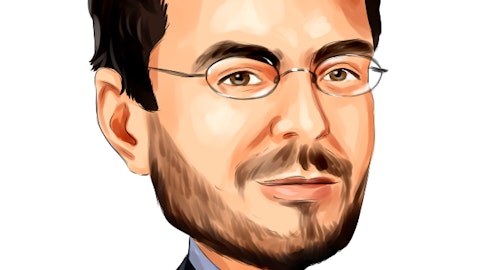Eric Shaff: No, it’s a great — thanks for the question. Maybe I’ll ask Matt to start and I might suggest that we start with the first cohort data that we saw which is really encouraging to us. And then maybe Lisa can comment on her perspective as well as the regulatory landscape.
Matthew Henn: Yeah, right. So Chris, as a reminder, SER-155 is really designed to target two specific areas. One is the domination of pathogens and the incidence of that in the gastrointestinal tract, particularly of Enterococcus and a couple of Enterobacteriaceae species that are particularly problematic in this patient population. And the second is to improve immune tolerance in the gastrointestinal tract to have an impact on graft-versus-host disease, particularly in the GI where it’s most prominent in these particular patients. There is a strong literature and a deep literature that connects in particular, the disruption of the microbiome and that increased incidence in pathogen domination. To these various downstream clinical sequela that we’re looking at that Lisa talked about earlier, enteric infections, associated bloodstream infections and in particularly more severe forms of graft-versus-host disease.
So we believe actually both endpoints in terms of thinking about infections and the various ways we’re looking at that as well as graft-versus-host disease are very well founded, and we’ve substantial preclinical and clinical data that support our drugs can have an impact there. And I think most significantly is the cohort 1 data that we released last year, where we saw a substantial reduction in that incidence of pathogen domination in the gastrointestinal track relative to control court. Remember, we saw a single patient having one of these pathogen overgrowth events where we would have expected that to be of substantially higher in the order of about 60-plus percent of patients having such. So with that, I’ll turn it over to Lisa.
Lisa von Moltke: Sure. So I would just say that the — both areas, the GvHD as well as the infection protection area, huge interest to both the medical community and the regulators. GvHD, we now have a guidance from the regulatory folks at FDA. So we know what they would want there. I think the infection protection side has numerous programs coming out of the agency to encourage development work there. It obviously is adjacent to the C. diff area in terms of our results and our ability to show results there. And we could imagine a number of endpoints lining up from high — very high frequency events such as neutropenia and fever, and all the way down to the incidence of particular infections such as the GI tract. All of those lining up would make a very powerful story. And the agency has talked about that before with regard to primary and secondary endpoints lining up and the strength that, that gives an approach.
Chris Shibutani: Great. Appreciate the additional thoughts.
Lisa von Moltke: But you can see I have a little bit of a preference.
Chris Shibutani: Yeah. No, that comes through. Thank you so much.
Eric Shaff: Thanks for the question, Chris.
Operator: And we will take our final question from Keay Nakae with Chardan. Your line is open.
Keay Nakae: Yes, thank you. So having implemented the head count reduction late last year, to what extent — and again, I know you’re very focused on the launch of VOWST, but to what extent, if any, at this point, do you feel like the current headcount and operating plan is in any way constraining what you’d like to do on the marketing side for VOWST? Thanks.
Eric Shaff: Yeah, good morning, and thanks for the question. I would say that our headcount reductions constrained a number of things, in particular, on the R&D side of our portfolio. But from a marketing investment, we work with Nestle, we have contractual parameters by which the budget is set and executed against. So we don’t believe the headcount reduction has an impact on the investment to support the VOWST launch.
Keay Nakae: Okay. Thanks.
Eric Shaff: Sure.
Operator: And ladies and gentlemen, there are no further questions at this time. So I will now turn the call back to Mr. Eric Shaff for closing remarks.
Eric Shaff: Thank you, and thanks to everyone for joining us this morning. We look forward to keeping you updated on our progress. Hope you have a great morning, great day and a great week. We’ll talk soon. Thank you.
Operator: And ladies and gentlemen, this concludes today’s call, and we thank you for your participation. You may now disconnect.
Follow Seres Therapeutics Inc. (NASDAQ:MCRB)
Follow Seres Therapeutics Inc. (NASDAQ:MCRB)
Receive real-time insider trading and news alerts




